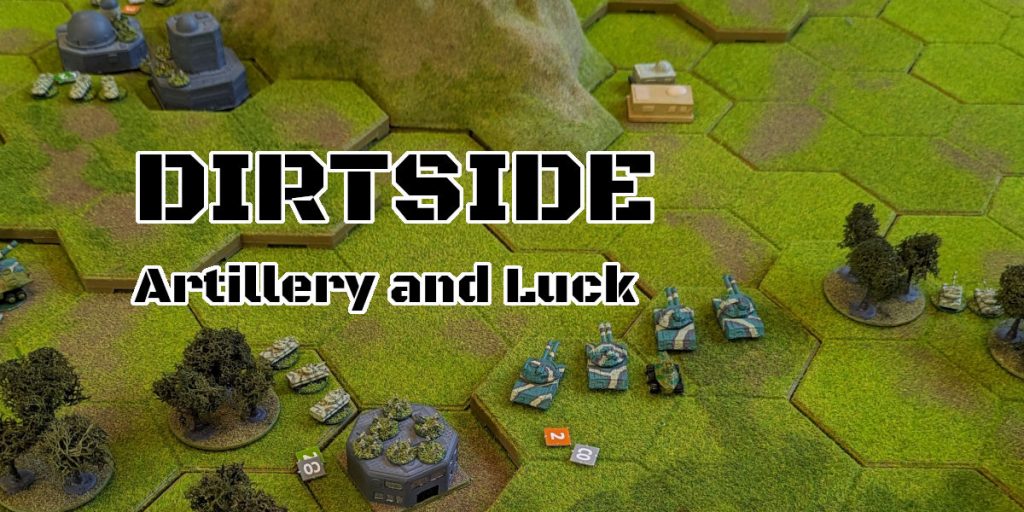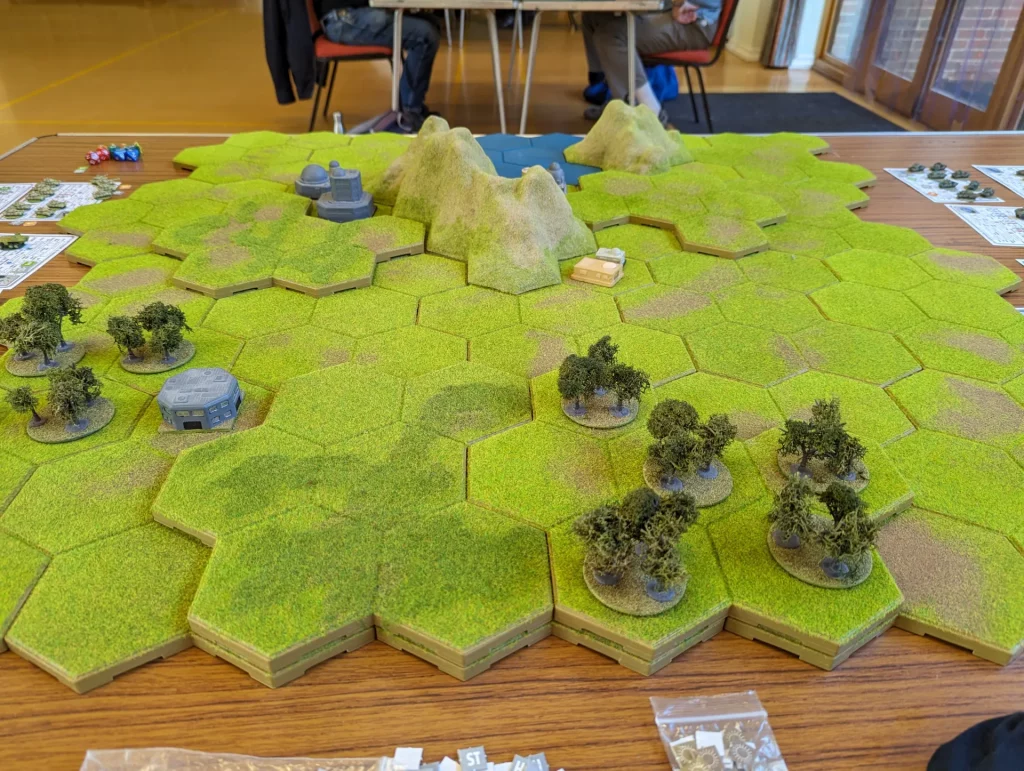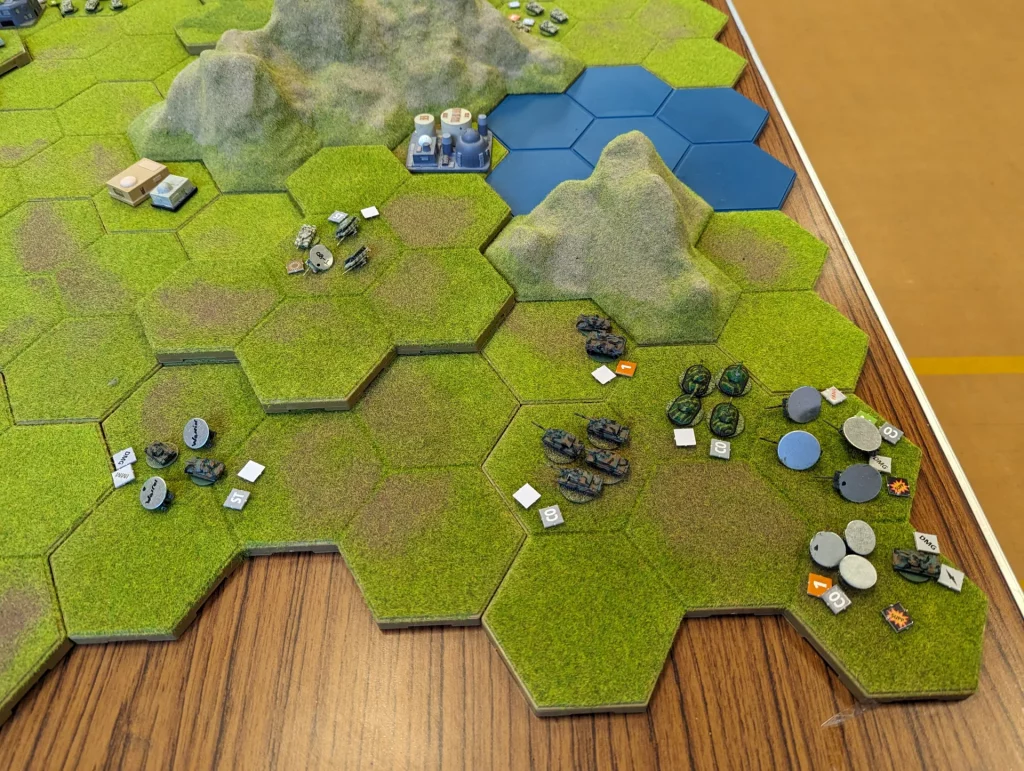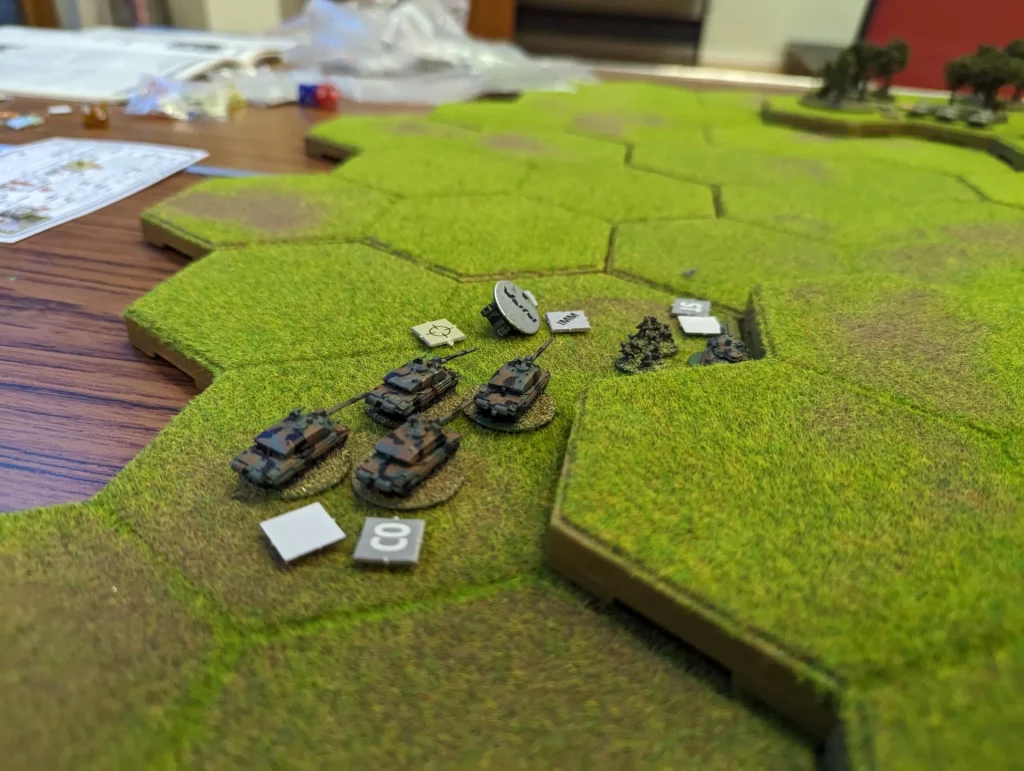Artillery and Luck

Our Friday night game this week was a return to Dirtside II, using some of the new vehicle stats I had been working on. The scenario was a near future engagement between NATO and Russia, with NATO forces trying to take some objectives from the defending dug-in Russians.
The two forces were closely balanced on points, each just over 5,000. It was mostly tanks, with some artillery on the Russian side and an aerospace bomber on the NATO side.
For the first time, I had decided to take along my Kallistra hex terrain to the club. It’s a bit more cumbersome to travel with than a simple battlemap, but does allow more complicated multi-layer terrain features to be built up. This was just over a box worth of terrain. We could probably have done with a bit more to make the battlefield that bit larger.
One problem that we have with the tables at the club, is that they have a ridge around the outside of them that sticks up several millimetres. This gives an annoying ‘bump’ along the centre line when using a battlemap. The gap on the underside of the hex tiles is just tall enough to clear this ridge, giving us a nice flat surface.
As the Challenger 2 tanks rolled onto the battlefield, they opened up on a unit of T-80s hiding up in the hills. It was a highly effective assault, with three of the four T-80s being taken out in the opening salvo. The remaining tank managed to radio in artillery support, and from that point things started to go wrong for the NATO forces.
With the units coming in from one direction, a single open sheaf artillery strike managed to hit several units. The command unit made it clear, but the others didn’t. A unit of Challenger 2 tanks was almost wiped out, and three Saxon APCs were destroyed. It is a very lucky strike by the Russians. The Green troops in the Challenger unit panicked, which wasn’t that surprising.
I needed to clear the route through the valley, so called in some air support. The Russian AA radar locked onto the aircraft, and the pilot decided to abort their bombing run.
It was then that the T-37s on the far ridge line opened up. The T-37s (2037, not 1937) were a near-future design of super heavy tank (size 6), with twin class 5 Hyper-Kinetic cannons. They were the heaviest tanks that the Russians had, and they turned out to be highly efficient.
Sitting up on the hill, and with a maximum range of 60″, they could reach most things on the battlefield. They managed to take out the remains of the Challenger tanks that had suffered artillery bombardment.
So it was time to bring in my GEVs. They headed for the open water, where they would be able to cross to get behind enemy lines. My warriors also moved up towards the valley, hoping to keep in cover from the T-37s, but the T-80s managed to get some accurate hits in.
By turn two, things weren’t looking good for NATO. The artillery strike had been highly effective, and the T-37s were as formidable as I’d expected. What I hadn’t expected was for my aerospace bomber to not achieve anything.
I tried to bring in my bomber again, and this time it wasn’t scared off by the Russian AA. However, it was shot down before it could do anything. Fortunately, a attempt by the Russians to bring in more artillery failed, allowing me to move my Challengers around into the mouth of the valley and take out one of the T-80s hiding at the edge of the woods on the hill top.
Eventually the Russians succeeded in another artillery barrage. The infantry in the warriors quickly abandoned their immobilised vehicle, which promptly vanished in a blast of anti-vehicle artillery. A couple of the Challengers were also damaged.
The last few engagements didn’t go well. I turned out to be incapable of rolling anything higher than a 2 in my attacks, and I was losing vehicles and men all over the place. The GEVs were doing okay against the T-80s at the rear, but they were pretty much on their own. So at this point I decided that it was time to pull back and consider the game a loss.
Things had started well for NATO. The initial unit of T-80s, even though they had been dug-in up on the hills, were no match for a unit of Challenger 2s. But bad luck with NATO dice rolling, and good chit drawing and rolls from the Russians had meant that was the first and last ‘win’ of the battle.
Nobody got to use missiles, and my aerospace bomber which I was worried would be too effective turned out to have no effect on the game at all.
I’d known bringing all my units in together had been a risk given that the Russians had artillery, but I hadn’t expected the artillery to be as effective as it had been. My other option had been to split my forces, but I decided against doing that. It probably would have been better if I’d brought units in from both corners, maybe going up through the hills and woods to take the T-37s on at close range against their side armour.
The T-37s had been deadly, and nobody got to fire on them. I had decided to make a small rule change which favoured the big guns – treating ‘Firer System Down’ as a non-event. When I’d done a solo match between Challengers and T-80s, I’d lost a lot of tanks to this chit, and it hadn’t felt right. Maybe it’s there for game balance, but the chances seemed too high.
Anyway, it was interesting to see how the vehicles played out against each other. I think a slightly bigger table would help for future games. I do like the rule system (though tidying up the chits at the end is always a big pain), and I think it covers a lot of things that need to be covered for this sort of game – artillery, aerospace operations, armour and infantry units.
I’d mostly thrown in the SciFi vehicles due to having only a limited selection of modern vehicles. A second package has turned up, so I just need to paint those to give me a bigger selection. I’m interested in doing a variety of ‘early 21st century’ scenarios, with anything from just modern warfare up to post-nuclear and maybe OGRE style scenarios. I think Dirtside can handle all of these, though I’ve picked up a couple of other rule systems (Five Core Company Command and Future War Commander) to take a look at.
One aspect of modern warfare that might need some extra rules concerns the use of drones. They’re mentioned in Dirtside, but I don’t think it goes into too much detail (the rules were written in the 1990s, before drones really became a ‘thing’). Large drones like Reapers will just be aerospace vehicles, but the sort of small and cheap drones currently being used in Ukraine are a different thing altogether.




